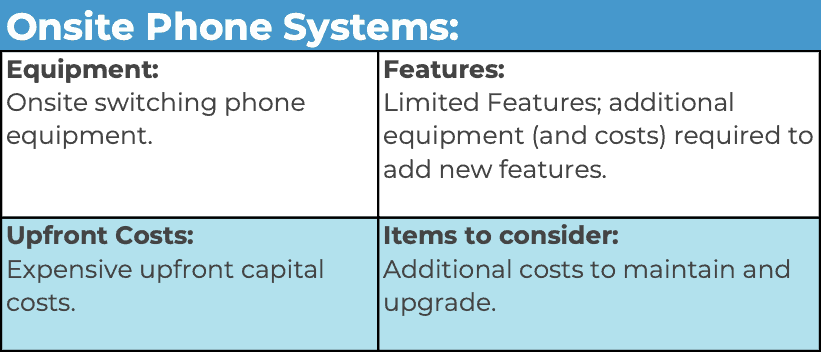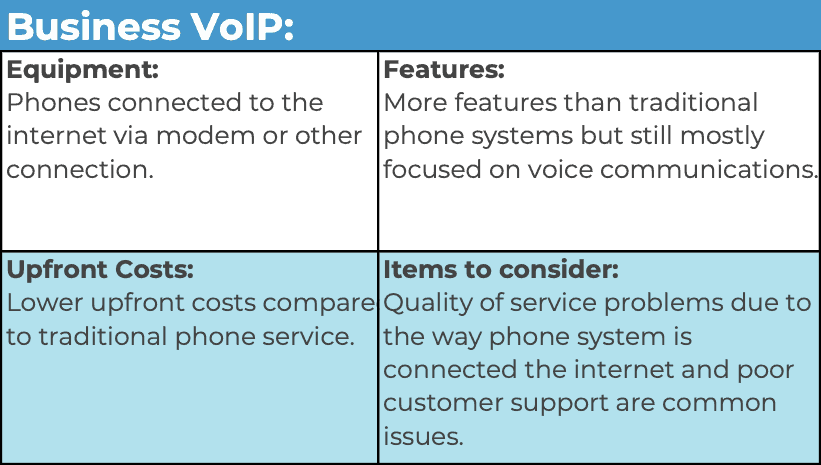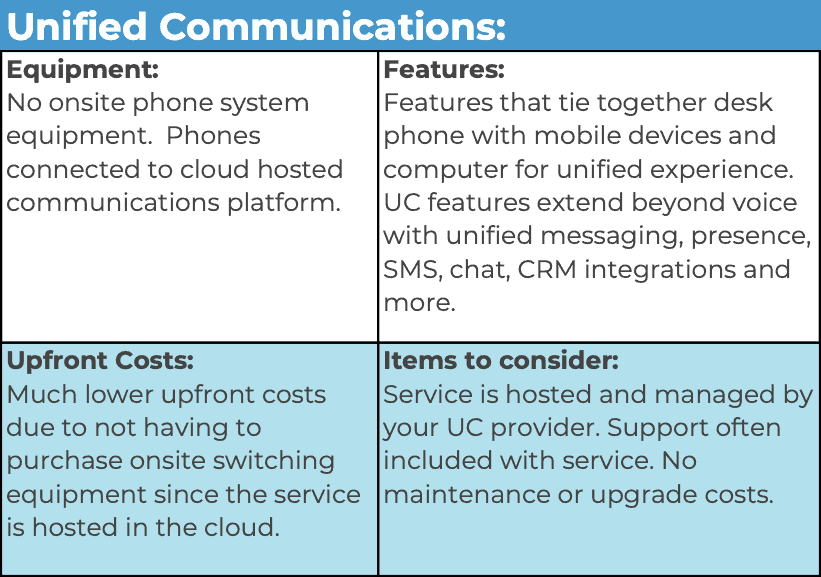There have been many changes in business voice service within the last few years. One might even say there has been an evolution or maybe even a revolution within the industry from traditional onsite phone systems to VoIP to Unified Communications.
Until recently, very few options existed for business voice service. In the past, phone systems required purchasing expensive onsite equipment and connection through a local phone provider. Today, with the help of new innovations and technology such as the internet and the cloud, business phone service has evolved rapidly from voice-only communications to a connected, integrated communications platform. The introduction of more options and choices can lead to a lot of potential pitfalls. Not all providers and services are created equally. It is a whole new ballgame as far as understanding recent changes and the options that are available for business customers.
See below for a brief overview of a few different types of business voice communications solutions:
THE OLD WAY: TRADITIONAL ONSITE SYSTEM
Traditional onsite phone service requires purchasing equipment as well as monthly service through a local phone provider. The equipment determines both the number of internal users and the various calling features that are available. As your company grows, you have to purchase additional equipment to support additional users or new features.

The bottom line for Traditional Phone service is focused on traditional voice calling. Expensive onsite equipment. Costs to upgrade and maintain. Limited features.
A NEWER WAY: VOIP
VoIP stands for Voice over Internet Protocol. It can also be called Voice over IP or IP telephony. VoIP is a technology that allows for the delivery of voice communications over Internet Protocol (IP) networks, most commonly the Internet.

The bottom line for Business VoIP service: Still focused on traditional voice calling but for a lower cost than onsite systems. More features but also more quality issues. A lower-cost approach often comes with inferior customer service and support.
THE BEST WAY: UNIFIED COMMUNICATIONS
Unified Communications (UC) is the integration of enterprise communication services via a common platform that improves, enhances, and facilitates better overall connectivity, information, and end-to-end solutions. UC is more than just voice service. It allows for unified messaging, presence, SMS, Chat, and connectivity to CRM systems. It requires very little since the cloud hosts the phone system requirements. New users can easily be added or removed without incurring additional capital equipment costs.

The bottom line for Unified Communications service: Voice calling with more features, functionality, and mobility included. Still lower cost than onsite systems and comparable with VoIP systems. Fewer quality issues and more integration lead to increased productivity.
➡️ Ready for more about Unified Communications? Check out our “Ultimate Guide To UCaaS” now!
Your business voice service is important for driving sales and supporting existing customers. In today’s fast-paced, technology-driven business environment, your voice service provider should offer more than just voice communications (making and receiving calls). In order to support diverse teams, increase efficiency, and avoid communication gaps, companies need a voice solution that extends, integrates, and connects. Business communications need to encompass a variety of scenarios, such as multiple offices, a mobile workforce, field employees, remote workers, and call center support.
See the infographic below on the Evolution of Business Voice service:
About Level365: Level365 offers a complete Unified Communications as a Service (UCaaS) solution complete with voice, video, and collaboration to simplify business communications. Our service integrates communication among desk phones, computers, and mobile devices for a seamless experience anytime, anywhere. The UC platform extends beyond voice communications with Unified Messaging, Presence, Chat/SMS, Cloud Faxing, Business Systems Integration and more.





